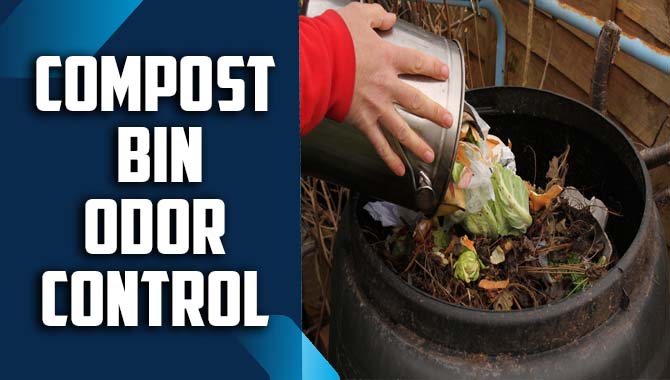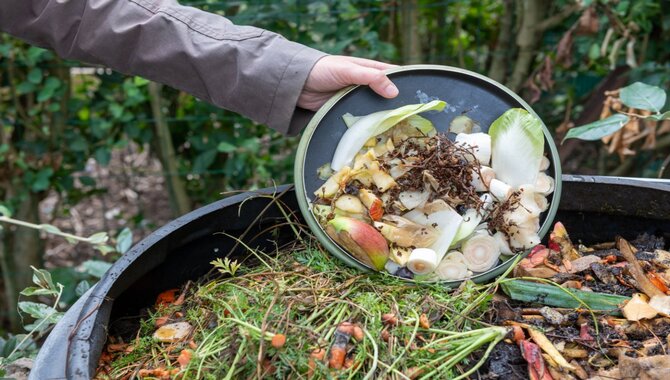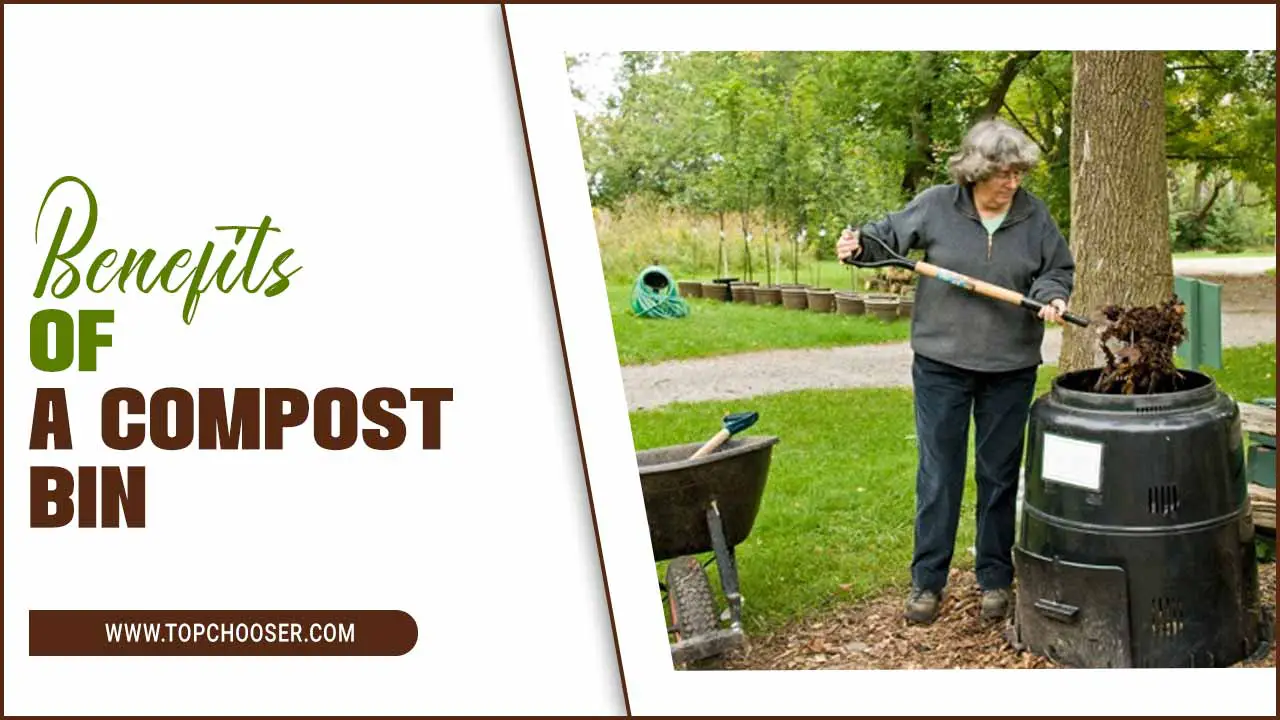Composting is an environmentally friendly way of reducing waste and enriching soil, but the smell that comes with it can be a major turnoff. If left unmanaged, a compost bin can produce an unpleasant odour that can cause discomfort to the surrounding environment.
This can be especially problematic if you live in an urban setting, where neighbours might complain about the smell. Fortunately, there are ways to control compost bin odours and make the process more tolerable. We’ll also discuss the common causes of compost bin odour and how to prevent them. From natural odour control agents to proper maintenance and ventilation, there are several effective ways to manage compost bin odours.

What Is Compost Bin Odour?

Compost bin odour refers to the unpleasant smells that can arise from a composting system. Various gases are released as byproducts when organic matter decomposes in a compost bin. These gases, such as ammonia, hydrogen sulfide, and volatile organic compounds (VOCs), can create a foul smell that can bother the surrounding environment.
Compost bin odour can be intensified by factors like the improper balance of carbon and nitrogen, excessive moisture, lack of oxygen, or rotting or putrefying materials. Managing compost bin odour is essential to ensure a more pleasant composting experience and to prevent any potential nuisance to nearby areas.
Top 5 Reasons Why Your Compost Is Smelling

Smelling compost is important because it can indicate its condition and guide composting practices. A healthy compost pile should have an earthy smell, indicating proper decomposition. Foul odors like ammonia or rotting may suggest an imbalance, such as excessive moisture or lack of aeration. Monitoring smells helps maintain an effective composting process.
1.Improper Balance Of Carbon And Nitrogen
Compost requires a proper balance of carbon-rich “browns” (such as dry leaves, straw, or sawdust) and nitrogen-rich “greens” (such as kitchen scraps or fresh grass clippings). If the balance is off and there is excess nitrogen, it can lead to a strong and unpleasant odour.
2.Excessive Moisture
The compost should be moist but not overly wet. If it becomes too wet due to rain or overwatering, it can create a stagnant environment where anaerobic bacteria thrive. These bacteria produce foul-smelling gases, resulting in a stinky compost pile.
3.Lack Of Oxygen
Oxygen is crucial for the decomposition process in a compost bin. If the compost pile becomes compacted or densely packed, it restricts airflow and reduces oxygen levels. This can cause anaerobic decomposition, leading to the production of odorous gases.
4.Inclusion Of Inappropriate Materials
Certain materials should not be added to a compost bin as they can contribute to bad smells. Avoid adding meat, dairy products, oily foods, or pet waste, as they can attract pests and produce strong odours when decomposing.
5.Presence Of Rotting Or Putrefying Materials
If your compost pile contains rotting or putrefying materials, it can emit unpleasant smells. Regularly turn and mix the compost to prevent any pockets of decomposition and ensure proper airflow.
Odour Control Equipment

Air Scrubbers: Air scrubbers remove contaminants, including odorous particles, from the air. They use filters and/or chemical reactions to capture and neutralize odours, improving air quality.
Activated Carbon Filters: These filters are highly effective at trapping and adsorbing odorous compounds. Activated carbon has a large surface area that can bind to odorous molecules, reducing their presence in the air.
Ozone Generators: Ozone generators produce ozone molecules, which react with and break down odorous substances. They are often used in industrial or commercial settings to neutralize strong smells.
Biofilters: Biofilters utilize a bed of organic material (e.g., compost, wood chips) inhabited by microorganisms. The odorous air is passed through the biofilter, and the microorganisms degrade the odour-causing compounds biologically.
Chemical Scrubbers: Chemical scrubbers use a chemical solution to absorb or chemically react with odorous gases. They are commonly employed in industrial facilities to control strong odours.
Uv-C Light Sterilizers: UV-C light can neutralise odour-causing bacteria, viruses, and fungi. UV-C light sterilizers are often used in enclosed spaces to control microbial growth and reduce odours.
Odour Neutralizing Agents: These agents chemically react with odour molecules to neutralize them. They are available in various forms, such as sprays, gels, or solid inserts, and are commonly used in homes, offices, and public spaces.
Ventilation Systems: Proper ventilation plays a crucial role in odor control. By continuously exchanging indoor air with fresh outdoor air, ventilation systems help remove odorous particles and maintain a more pleasant environment.
Compost Bin Odour Control Step By Step

Composting is an excellent way to reduce your environmental footprint by turning kitchen scraps and yard waste into nutrient-rich soil for your garden. However, a common challenge of composting is managing the odour from decomposing organic matter. Fortunately, there are several steps you can take to control compost bin odour.
Make sure your compost bin is properly aerated. Good airflow is essential to prevent anaerobic decomposition, which produces a foul smell. Turn your compost pile regularly to ensure oxygen reaches all parts of the bin. Balance your compost ingredients.
Balancing brown and green materials will help create a healthy compost pile and prevent odour. Brown materials, such as dried leaves and wood chips, provide carbon, while green materials, such as food scraps and grass clippings, provide nitrogen. cover your compost bin with a lid or tarp to keep out pests and prevent excess moisture from accumulating. Too much moisture can lead to anaerobic decomposition.
Odour Control System
An odour control system has become essential in various industries and settings, from wastewater treatment plants to commercial kitchens and public restrooms. These systems work by neutralizing or eliminating unpleasant odours that can cause discomfort and health hazards for workers and visitors. The technology behind odour control systems has evolved over the years, and today’s systems are more efficient, eco-friendly, and cost-effective than ever before.
One of the main benefits of odour control systems is that they create a safer and healthier environment for everyone. Odours are unpleasant and can indicate the presence of harmful substances or gases, such as ammonia or hydrogen sulfide. By eliminating these odours, odour control systems can help prevent respiratory problems, headaches, and other health issues caused by exposure to toxic substances.
Another advantage of odour control systems is that they can improve the overall quality of life in a community or workplace. Unpleasant odours can be a source of stress and discomfort, affecting people’s moods and productivity.
Why Odor Control System
Improved Air Quality: One of the primary reasons for implementing an odour control system is to enhance air quality in a specific environment. Unpleasant odours can negatively impact individuals’ comfort and well-being in residential, commercial, or industrial settings. An odour control system helps to minimize or eliminate offensive odours, leading to a more pleasant and healthier indoor or outdoor atmosphere.
Environmental Compliance: Implementing an odour control system enables businesses to comply with these regulations, avoiding potential fines, penalties, or legal issues. Companies can demonstrate their commitment to environmental responsibility by effectively managing odours and maintaining a positive reputation.
Prevention of Complaints and Nuisance: Offensive odours can generate complaints from residents, neighbours, or nearby businesses. An odour control system helps prevent these complaints and reduces the likelihood of becoming a nuisance to others.
Health and Safety Considerations: Some odours may pose health and safety risks. For example, certain industrial processes or chemical emissions can release toxic or harmful gases that must be controlled to protect workers and the surrounding community.
Odour Source Identification: Implementing an odour control system often involves identifying the sources of odours. This process helps businesses pinpoint underlying issues such as equipment malfunctions, leaks, or improper waste management practices.
How To Compost Without Smell
Composting is a fantastic way to reduce waste and create nutrient-rich soil for your garden. However, many people avoid composting because they worry about the smell. Luckily, there are several ways to compost without any unpleasant odours.
First, be mindful of what you add to your compost pile. Avoid adding any meat, dairy, or oily foods, as these can create a strong odour. Instead, focus on adding fruits, vegetables, and other plant-based materials. You can also try layering your compost pile with materials like leaves or shredded paper to help absorb any odours.
Another option is to use a compost bin with a ventilation system that circulates air, reducing the chances of any smells building up. Finally, turn your compost pile regularly to speed up the decomposition process and prevent any unpleasant odours from developing. With these tips in mind, you can enjoy all the benefits of composting without any worries about unpleasant smells.
How To Get Rid Of The Smell In A Compost Bin
If you have a compost bin, you may find that it starts to emit an unpleasant odour over time. Fortunately, several ways exist to eliminate the smell and keep your compost bin fresh. First, make sure that the bin is properly aerated.
You should turn the compost regularly to introduce oxygen and prevent anaerobic conditions, which can lead to odour-causing bacteria. Additionally, you can add materials that absorb moisture and neutralize odours, such as dry leaves, shredded paper, or activated charcoal.
If the bin is particularly wet, you may need to add more dry materials to balance it. Another option is adding a compost accelerator, which contains bacteria that quickly and effectively breaks down organic matter. Some people also like to add essential oils, such as lavender or peppermint, to their compost bin to mask any remaining odours. Lastly, be mindful of what you are adding to the compost bin in the first place.
How Do You Stop Your Indoor Compost From Smelling?

1.Choose An Appropriate Container:
Select a container specifically designed for indoor composting, such as a sealed compost bin or a composting tumbler with an airtight lid. Ensure the container has proper ventilation to allow for airflow while containing odours.
2.Use A Compostable Liner:
Line your compost container with a compostable liner or biodegradable bag. These liners help absorb excess moisture and prevent the accumulation of odorous residues in the container.
3.Properly Manage Moisture:
Maintain the right moisture level in your indoor compost. Too much moisture can lead to anaerobic conditions and unpleasant smells. Monitor the moisture content regularly and add dry materials like shredded paper or dry leaves to absorb excess moisture.
4.Add Odor-Absorbing Materials:
Include odour-absorbing materials in your indoor compost. For example, you can add a layer of activated carbon, baking soda, or crushed charcoal to help neutralize odours. These materials can be sprinkled between compost layers or placed in small open containers within the compost container.
5.Regularly Empty And Clean The Container:
Empty your indoor compost container frequently to prevent the buildup of odours. Transfer the contents to an outdoor compost pile or a composting facility. After emptying, clean the container with water, vinegar, or mild detergent to remove any residual odours and maintain cleanliness.
6.Techniques For Controlling Odour In Compost Bins
Composting is essential to sustainable living but can often lead to unpleasant odours in your backyard. Luckily, there are several techniques for controlling odour in compost bins. Mixing your green and brown materials thoroughly is an effective way to manage odour.
Green materials, such as grass clippings and kitchen scraps, are high in nitrogen and can cause odours if left unchecked. Brown materials, such as leaves and twigs, contain carbon and help to balance the nitrogen-rich green materials. Another technique is to aerate your compost regularly using a pitchfork or compost turner. Oxygen is essential for breaking organic matter; a well-aerated compost pile will generate less odour.
Adding an absorbent material like shredded newspaper or sawdust can also help to control odours. These materials absorb excess moisture and reduce the likelihood of anaerobic conditions that produce unpleasant smells. Finally, it’s important to monitor the moisture content of your compost pile.
Natural Odour Control Methods For Compost Bins

Proper Balance Of Materials: Maintain a proper balance of carbon-rich “browns” and nitrogen-rich “greens” in your compost bin. This helps create a well-balanced environment for decomposition and minimizes the risk of odours. Adjust the ratio as needed to ensure a balanced mix of materials.
Layering: Alternate layers of browns and greens as you add them to the compost bin. This layering technique aids in proper decomposition, promotes airflow, and reduces odour potential. Start with a layer of browns at the bottom of the bin and continue to alternate layers.
Aerating And Turning: Regularly aerate and turn the compost to introduce oxygen and promote aerobic decomposition. Oxygen helps beneficial microorganisms thrive while reducing the likelihood of anaerobic conditions that lead to odours. Use a garden fork or compost-turning tool to mix the materials thoroughly.
Add Absorbent Materials: Include absorbent materials in your compost bin to help manage moisture and control odours. Dry materials like shredded paper, dry leaves, or sawdust can absorb excess moisture and prevent the development of foul smells.
Citrus Peels Or Herbs: Adding citrus peels or aromatic herbs like mint, rosemary, or lavender to your compost bin can help mask unpleasant odours naturally.
Baking Soda: Sprinkling a small amount of baking soda in your compost bin can be a natural deodorizer.
Yarrow Or Chamomile Tea: Brew yarrow or chamomile tea and let it cool. Then, pour the cooled tea over your compost pile. The tea acts as a natural odour suppressant and can help control odours.
Commercial Odour Control Products For Compost Bins
It can also create unpleasant odours that can be a nuisance for those nearby. This is where commercial odour control products for compost bins come in. These specialized products are designed to reduce and eliminate odours from composting organic matter.
They target the bacteria and fungi that cause the odours, breaking them down into harmless substances. Various types of commercial odour control products are available for compost bins, including sprays, pellets, and granules.
Some are designed to be added directly to the compost bin, while others are used as a cover or sprayed onto the surrounding area. When choosing a commercial odour control product, it’s important to consider factors such as effectiveness, ease of use, and environmental impact. Some products may contain chemicals that could harm plants or animals.
Conclusion
controlling compost bin odours is essential not only for your comfort but also for the environment. By following the tips and tricks discussed in this post, you can effectively reduce unpleasant smells and maintain a healthy and productive composting system.
Remember to balance the ingredients in your compost, keep the bin well-aerated, and use natural odour absorbers to keep your compost bin smelling fresh. With a little effort and attention, you can enjoy the many benefits of composting without the unpleasant odours.
FAQs
[rank_math_rich_snippet id=”s-2bb506db-cded-4a0a-8849-d76e40adde94″]

I am passionate about home engineering. I specialize in designing, installing, and maintaining heating, ventilation, and air conditioning systems. My goal is to help people stay comfortable in their homes all year long.








